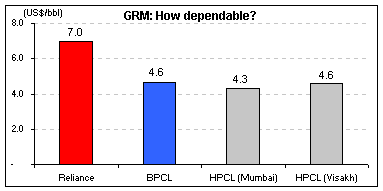Oil marketing PSUs have posted robust FY04 results. Bharat Petroleum Corp recorded an 11 per cent topline and 36 per cent bottomline growth, while HPCL's topline grew by 6 per cent and bottomline by 24 per cent during the year. The performance could have been better but for the freeze on prices. The companies' refineries are amongst the best in the country and with future plans of expansion and upgradation, are likely to play a substantial role in growth.
It should be noted that oil refining companies, to a large extent, benefited from high gross refining margins during FY04 as a result of firm product prices in international markets (refineries enjoy import parity prices of products). However, comparing efficiency of one refinery with another on the basis of gross refining margins depicts a wrong picture of the performance.
For example, Reliance Industries' refinery at Jamnagar witnessed GRM of around $7 per barrel, while BPCL's refinery had a GRM of $4.6 per barrel and Hindustan Petroleum Corp's refining margins for its two refineries at Mumbai and Visakh were $4.3 per barrel and $4.6 per barrel respectively.
However, it must be noted that the Jamnagar refinery has a petrochemicals complex, the products of which are sold directly to customers, thereby including marketing margins. On the other hand, the PSU refinery products are sold to the marketing arm, which then sells it to the customers thereby accounting for the marketing margins separately.
Another important fact to note is that the gross refining margins also depend on how complex and flexible the refinery is at processing varieties of crude. To put things in perspective, BPCL's refinery can process nearly 60 different types of As we have earlier, GRMs do not give a clear picture of the performance of a refinery's performance, one should look at the complexity and flexibility of the refinery to handle and process various types of crude and the share of lighter distillates in the product mix. Just to put things in perspective, BPCL is setting up an FCCU (fluid catalytic cracking unit) and HCU (hydro-cracking unit), which shall enhance processing and help procure higher value lighter distillates, thereby increasing the realizations.
At the same time, the capacity is likely to be expanded to 12 MTPA (million tonnes) by the beginning of FY06 at a capex of Rs 18 bn. On the other hand, Reliance Industries' refinery at Jamnagar is one of the world's largest in terms of capacity (33 MMT) and is capable of producing high value products such as LPG and naphtha, which is further utilized as feedstock for the production of petrochemical products. In that sense, Reliance's refinery is better integrated and flexible as compared to its peers.
In recent times, investors have been disenchanted by the refinery stocks (both PSUs and private) owing to disinivestment blues and pricing ambiguity. Though long term prospects look encouraging, government control over pricing and other issues remain a concern. June 15, 2004 meeting on pricing may give some sense of direction. Equitymaster.com is one of India's premier finance portals. The web site offers a user-friendly portfolio tracker, a weekly buy/sell recommendation service and research reports on India's top companies.






 © 2025
© 2025